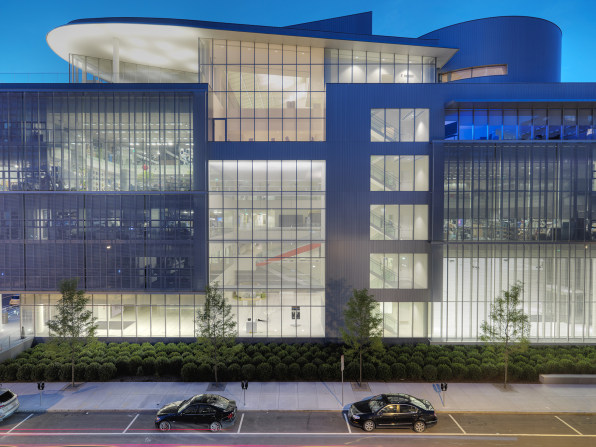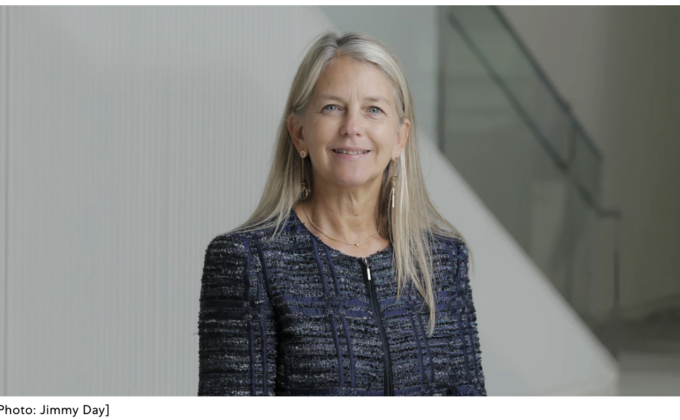If Willy Wonka had microchips, his factory would have been the MIT Media Lab. The 500-person facility actually houses 25 different research groups, which are known for creating some of the most wondrous marvels of our era—from computers you control with levitating orbs to architecture woven by silk worms.
Newman is a 28-year veteran of MIT herself, an Apollo Program Professor of Astronautics with over 300 publications to her name, who served as NASA Deputy Administrator from 2015–2017. She has been a principal investigator on four space missions, designed her own space suit, and is currently working with a combination of data visualization and AI to help regenerate the world’s oceans.
In one of her first public interviews since taking the role, Newman energetically outlines her updated vision for the MIT Media Lab—a rare innovation hub that she wants to see tackling tougher problems head on, and getting more involved with opportunities outside of the lab itself.

Fast Company: Why did you want this role? So much of your background is specifically in space exploration!Dava Newman: I’ve been a long-term MIT faculty member from tech and science. But the Media Lab has always been the most creative aspect at MIT for my whole career. Which is a long time! The Media Lab has been here for 35 years, and I’ve been here 28 years.
Things you might not know is that I teach Engineering Design [to many Media Lab students]. But I’ve been really personally fascinated with holistic design, is what I’d call it, from art to science, to engineering and design.
But if we were at our best, we’d be working across, among, and between art, science, engineering, and design. It’s always been a fascination of mine. So why the Media Lab? I can’t imagine a better place in the world to explore and be immersed in this trans-disciplinary thinking.
FC: So you’ve always been involved, indirectly, by teaching Media Lab students.
DN: Exactly, I’ve always been a friend and colleague [to the Lab]. And I’ve always been trying to get design [taught] across MIT.
FC: Where is there room for the Lab to grow? Where do you want to take it now?
It’s about the people. That’s the magic, the genius, that means our entire community. Everyone does bring a sparkle, something unique we can all learn from.
It’s going to be about parity . . . we can focus on all types of amazing things. But of those technologies and experiences we’re inventing, what will have the largest impact for society?
Then we get to play. This is a playful place. And it needs to be. Play brings out some of the best in us in terms of taking risks, trying this, trying that. It’s not linear thinking. You have to give yourself time to think and be creative.
And then the future state is “possibilities.” This is a lab of possibilities. We have to know what we want to be in the future. And what problems we want to solve as well.
FC: For sure, much of the Media Lab is filled with whimsy. But how do you balance this idea of play when you also want to focus on larger, real-world problems, like the environment?
FC: Talk to me about how you’re shifting the focus of the Lab itself.
DN: We’re asking, what are the hard questions?
This [other idea] is bubbling up: Policy, maybe? As [we develop] technologies and experiences for humanity, we have to think about, What are the future of governances around them? One example is our digital currency initiative. It’s amazing, but if you are going to have impact, it’s like you have to develop policy with tech.
We’re identifying, What are the tough challenges here? We’ll play in that space. If we get it right, we can hopefully have the most impact for society.
FC: It seems like the larger focus on the environment, equity, and policy are probably new for the Lab?
DN: I think that’s a fair assessment. Leadership matters, and that’s part of my leadership [focus]. So we’re going to put them at the forefront. I think that’s how we’re going to be what we aspire to be. We’re going to be a diverse and equitable place, we have to have everyone at the table. We do have these special talents. We can see solutions in envisioning things that are further out. We are built on literal media and data, so we don’t shy away from any technical challenges.
[I have] an AI platform engine curating petabytes of climate data I get every day from satellites . . . but what if you are immersed in that data, interacting with it? What if it’s education, but it’s tangible? And [what if] we’re not just doing this in this beautiful building, but it’s changing human behavior?
We have to be out in our community. We don’t have the answers. That’s the first thing we know about ourselves. We need to have a dialogue and be cocreating. We’re a smallish community in the scope of things, so how are we going to share that with the world?
FC: You stepped in after Joi Ito stepped down amid a lot of controversy. What are your priorities to get the Media Lab on track and repair the reputation?
DN: First and foremost, I need to give credit. There’s been great leadership in the last two years. The Media Lab was run by three senior faculty from the Media Lab. That hard, challenging work is well underway. It’s not finished, but they were working on culture and climate, on students, on funding and vetting funding. All that work no one knows about—it’s internal work. MIT [is following suit], but the Lab was first. I have the pleasure to continue that great work.
Then when it comes to external communication and visions, that’s where I’m putting together a team, bringing in some other senior folks when it comes to communications and a director of people.
FC: Will you still get your hands dirty in research? Or are you moving to a supervisor role?
DN: I get to do both. I have to figure out what the right balance is. Leadership, management—and fundraising does take up a lot of time. I’ll be measuring and monitoring it. I was in a lab for an hour last night, and of course I love it. Here’s the newest laser machine!
I have a large research portfolio myself. That is transitioning to make it more modest. [But] you don’t get kicked out of your lab! Getting people to Mars, I’m going to keep working on that!

